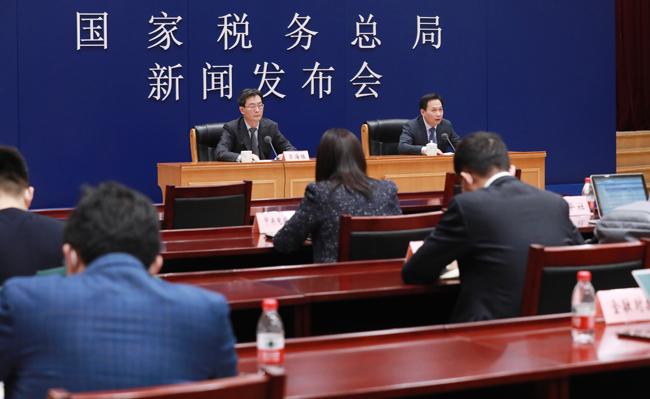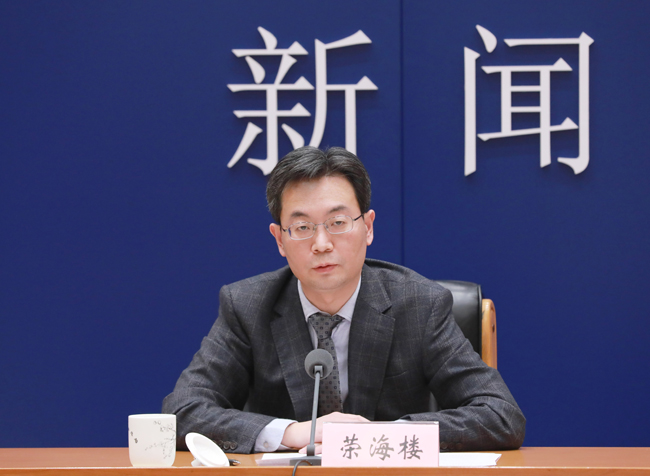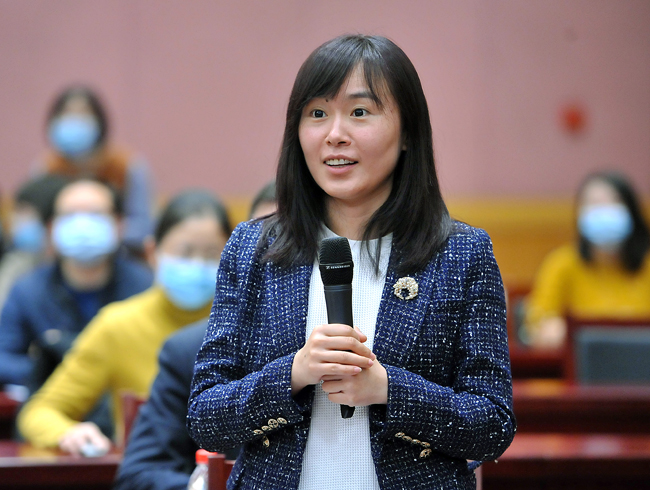State Taxation Administration of The People’s Republic of China held a press conference: Ten sets of tax data reflect that China’s economy will recover steadily and better than expected in 2020.

At the press conference of the State Administration of Taxation
Rong Hai building:Good morning, media reporters and friends! I am Rong Hailou, director of the Tax Publicity Center of the State Administration of Taxation, deputy director of the general office and spokesperson. Today, we invited Mr. Cai Zili, Director of the Revenue Planning and Accounting Department of the State Administration of Taxation, to attend the conference, introduce relevant information and answer your questions. We noticed that the major media were interpreting the economic and social development of China in 2020 and the 13th Five-Year Plan period through figures at the beginning of the year. In order to help you better understand China’s tax economy in 2020, we have specially combed 10 groups of data from the tax big data. Let’s invite Director Cai to give a detailed introduction.

Cai Zili, Director of Revenue Planning and Accounting Department of State Administration of Taxation
Cai Zili:Good morning, journalists and friends! In the past 2020, it was an extraordinary year. Facing the complicated and severe domestic and international situation and the severe impact of the COVID-19 epidemic, under the strong leadership of the CPC Central Committee with the Supreme Leader as the core, China coordinated the prevention and control of the epidemic and economic and social development, and handed over an answer that was satisfactory to the people, attracted worldwide attention and could go down in history. Taxation is often called the "barometer" of the economy. We fully tap the advantages of tax big data and systematically sort out ten sets of data to help you better understand the tax economy of China in 2020.
The first set of data: the annual tax revenue decreased by 2.6%, and the tax revenue target arranged in the fiscal budget was successfully completed.In 2020, the tax revenue (excluding export tax rebate) organized by the national tax authorities reached 13,678 billion yuan, down 2.6% year-on-year, and the tax revenue target arranged in the fiscal budget was successfully completed. From the trend of the whole year,The growth rate of tax revenue has rebounded for nine consecutive months since "bottoming out" in March.It reflects the good momentum of China’s economic recovery, but due to the epidemic situation and the implementation of tax reduction and fee reduction, the annual tax revenue decreased by 2.6%. During the "Thirteenth Five-Year Plan" period, the national tax revenue reached 65.7 trillion yuan, an increase of 18.5 trillion yuan over the "Twelfth Five-Year Plan" period, which provided a solid financial guarantee for economic and social development.
The second set of data: the proportion of tax revenue organized by tax authorities in fiscal revenue was 75.5%, an increase of 1.7 percentage points over 2019.In 2020, the tax revenue organized by the tax authorities will account for 75.5% of the general public budget revenue, an increase of 1.7 percentage points over 2019. Compared with 2015 at the end of the Twelfth Five-Year Plan, the proportion of tax revenue in fiscal revenue increased by 2.9 percentage points in 2020, which shows that the function of tax revenue in gathering wealth for the country continued to increase during the Thirteenth Five-Year Plan period.
The third set of data: the social security fee income collected by the tax authorities in the whole year was 3.8 trillion yuan, which provided a guarantee for the development of people’s livelihood.In 2020, the tax authorities will conscientiously implement the phased policy of reducing and exempting enterprise social insurance premiums and effectively reduce the burden on enterprises. Since November 2020, all social insurance premiums have been collected by the tax authorities. While maintaining the stability of the collection method, the tax authorities at all levels have continuously optimized the payment service, providing the majority of payers with various payment channels such as "online, handheld and self-help" to facilitate the payers to declare their payment. In 2020, the national tax authorities organized social insurance premium income of 3.8 trillion yuan.
The fourth set of data: the annual new tax reduction and fee reduction is expected to exceed 2.5 trillion yuan, successfully fulfilling the target of reducing the burden for enterprises as determined in the government work report.In 2020, the CPC Central Committee and the State Council will continue to increase tax reduction and fee reduction, and the tax authorities will implement it to the letter. In the first 11 months, the accumulated tax reduction and fee reduction will be 2,367.3 billion yuan, and it is expected to exceed 2.5 trillion yuan for the whole year, which can successfully complete the annual target of reducing the burden on enterprises as set in the 2020 government work report. During the "Thirteenth Five-Year Plan" period, the national new tax reduction and fee reduction is expected to exceed 7.6 trillion yuan. A series of practical tax reduction and fee reduction policies have effectively reduced the tax burden of enterprises, enhanced their sense of acquisition and stimulated the vitality of market players.
The fifth set of data: the proportion of tax revenue to GDP decreased by about 0.82 percentage points, and the tax burden of enterprises was further reduced.In 2020, with the implementation of tax reduction policies to support epidemic prevention and control and economic and social development, the proportion of tax revenue in China’s general public budget revenue is expected to drop to about 15.2%, which is about 0.82 percentage points lower than that in 2019.
The sixth set of data: the sales revenue of enterprises nationwide increased by 6%, and the production and operation of enterprises improved step by step.According to the VAT invoice data, in 2020, the sales revenue of national enterprises increased by 6% year-on-year. On a quarterly basis, it rebounded quarter by quarter, with a year-on-year decline of 17.6% in the first quarter, a 9% increase from negative to positive in the second quarter, a 12.4% increase in the third quarter and a further 15.7% increase in the fourth quarter. 29 of the 31 provinces achieved positive growth in sales revenue. The production and operation of enterprises are improving steadily. China is the first major economy in the world to control the epidemic, take the lead in resuming production and achieve positive economic growth. It is expected to become the only major economy in the world to achieve positive economic growth.
The seventh set of data: the sales revenue of high-tech industries increased by 14.7%, and the development potential of new kinetic energy was accelerated.In 2020, the national high-tech industry maintained a rapid growth trend, with sales revenue increasing by 14.7% year-on-year, which was 8.7 percentage points faster than the national average. Among them, the high-tech service industry represented by information services and e-commerce has increased by more than 20% year-on-year for nine consecutive months since April, with a cumulative increase of 23.6% for the whole year, indicating that the development potential of new kinetic energy has been accelerated and the new economy has continued to grow sturdily.
The eighth set of data: the R&D expenditure of key tax source enterprises increased by 13.1%, and the innovation and development situation continued to improve.In 2020, benefiting from preferential tax policies such as R&D expenses plus deduction, the R&D expenditure of key tax source enterprises in China is expected to increase by 13.1% year-on-year, of which the manufacturing industry will increase by 9.6% and the software and information technology service industry will increase by 25.3%, all of which maintain a good momentum of innovation and development. The amount of high-tech equipment and high-tech services purchased by 330,000 enterprises enjoying the policy of R&D expenses plus deduction increased by 15.8% year-on-year. During the "Thirteenth Five-Year Plan" period, the R&D expenditure of key tax source enterprises maintained a rapid growth rate of more than double digits, which added a strong stamina for the high-quality development of China’s economy.
The ninth set of data: 11.44 million tax-related market entities were newly established in the whole year, which was higher than the previous two years, and the market vitality was steadily enhanced.In 2020, the number of newly established tax-related market entities in the country reached 11.44 million, an increase of 10.1% over 2019, indicating that the state’s policies and measures to support market entities to solve problems and develop healthily have been effective and the market vitality has recovered rapidly. During the "Thirteenth Five-Year Plan" period, the total number of tax-related market entities newly established in China reached 57.45 million, of which the number of new offices in 2020 was significantly higher than that in 2018 and 2019.
The tenth set of data: the export tax rebate was 1,454.9 billion yuan in the whole year, which strongly supported the steady foreign trade.In 2020, the tax authorities implemented convenient measures such as paperless, "non-contact" and "tolerance handling" to speed up the progress of export tax rebate. The average time for processing normal tax rebate business was 20% faster than that in 2019, and the export tax rebate was 1,454.9 billion yuan in the whole year, which effectively eased the financial pressure on enterprises and played an important supporting role for the stable recovery of foreign trade. During the "Thirteenth Five-Year Plan" period, the country handled a total of 7,073.6 billion yuan of export tax rebates, an increase of 1,645.3 billion yuan over the "Twelfth Five-Year Plan" period, which effectively promoted the steady growth of foreign trade exports.
Around the above ten groups of data, we specially made vivid charts and sent them to you after the meeting, so that you can better understand and report.
Rong Hai Building: OK, thank you for your introduction. Let’s enter the question session.

The reporter from the Central Taiwan Broadcasting Station asked questions.
1. Reporter Yang Guang: Hello, Director Rong. Just now, Director Cai released ten sets of tax data, which gave a panoramic display of the tax economy operation last year and during the Thirteenth Five-Year Plan period. Could you please briefly introduce the tax department’s deepening of the application of tax big data?

Rong Hailou, Director of the Tax Publicity Center of the State Administration of Taxation, Deputy Director of the General Office and Spokesman
Rong Hai building:Thank you for your question. Tax big data has the advantages of strong timeliness, wide coverage and fine granularity, which records the production and operation status of market players and can reflect the economic operation more quickly, comprehensively, accurately and objectively. In recent years, the tax authorities have conscientiously implemented the decision-making arrangements of the CPC Central Committee and the State Council on using big data to improve the modernization level of national governance, and carried out in-depth construction and application of tax big data. Especially in 2020, in the face of the sudden COVID-19 epidemic, the Party Committee of the State Administration of Taxation put forward the requirement of "data service should be strengthened", gave full play to the advantages of tax big data, fully supported the overall prevention and control of epidemic situation and economic and social development, and made beneficial explorations in helping market players to solve problems, implementing tax reduction and fee reduction policies, and serving macroeconomic decision-making.
First, play the role of data bridge to support enterprises to resume work and production.Using the advantage of connecting the upstream and downstream of the industrial chain with VAT invoice data, we can accurately locate key enterprises and their main business related parties that are affected by the epidemic situation, promote the docking of supply and demand sides according to the principle of marketization, smooth the supply chain cycle of the industrial chain, carry out targeted assistance and support the development of enterprises.
The second is to accurately locate demand and promote tax reduction and fee reduction.Relying on tax big data, we will accurately screen eligible taxpayers, take the initiative to publicize and coach, and track and monitor in real time to ensure that policy dividends reach market players with the fastest speed and the most accurate accuracy. Just now, Secretary Cai introduced that the new tax reduction and fee reduction last year is expected to exceed 2.5 trillion yuan, and big data has played an important role in it.
The third is to objectively reflect the economic operation and make service decisions.Tax big data can not only timely monitor the process of resuming work and production, but also objectively reflect the macroeconomic operation and assist economic decision-making.
Tax big data has great potential. In the next step, the tax authorities will continue to deepen data sharing, improve data algorithms, and give full play to the advantages of tax big data, focusing on accurately grasping the new development stage, thoroughly implementing the new development concept, accelerating the construction of a new development pattern, selecting and analyzing topics, digging deep into the economic laws and characteristics reflected by the data, and continuously creating authoritative and reliable tax economic analysis products to better support the development of market players and better serve macroeconomic decision-making.

People’s Daily reporter asked questions.
2. People’s Daily reporter: Just now, Secretary Cai introduced that in order to support epidemic prevention and control and economic and social development, in 2020, China expects to increase taxes and reduce fees by more than 2.5 trillion yuan. Could you please ask Director Cai to introduce the implementation effect of tax reduction and fee reduction in 2020?
Cai Zili:In 2020, the tax authorities resolutely implemented the decision-making arrangements of the CPC Central Committee and the State Council, and adopted a series of practical and effective measures to ensure that the "real money" of tax reduction and fee reduction accurately reached market players. It is estimated that the annual tax reduction and fee reduction will exceed 2.5 trillion yuan, successfully fulfilling the annual burden reduction target set in the 2020 government work report, and exceeding the scale of larger tax reduction and fee reduction in 2019. The main achievements are as follows:
First, the tax burden of Chinese enterprises continues to decline.Since the "Thirteenth Five-Year Plan", with the implementation of a series of large-scale tax reduction and fee reduction policies and measures, from 2016 to 2019, the proportion of tax revenue in China’s general public budget revenue to GDP was 17.47%, 17.35%, 17.01% and 16.02% respectively, and it is expected to further drop to about 15.2% in 2020, which is about 0.2% lower than that in 2019. Accordingly, the tax burden of Chinese enterprises has been reduced year by year. The tax burden rate of sales revenue of 100,000 key tax source enterprises monitored by the State Administration of Taxation (that is, the proportion of tax and social security fees paid by enterprises in sales revenue) is expected to decrease by 8% year-on-year in 2020, and it has decreased by 18.1% since the Thirteenth Five-Year Plan.
Second, the real economy and the private economy benefit the most.In 2020, tax reduction and fee reduction will focus on helping market players to solve problems and promote economic recovery growth. Among them, the new tax reduction and fee reduction in manufacturing and related links is expected to account for about 35%, which is the industry that benefits the most; The new tax reduction and fee reduction in the private economy is expected to account for about 70%, with the most obvious benefits. Thanks to the tax reduction and fee reduction policy, in 2020, the tax burden rate of sales revenue of key tax source manufacturing and private enterprises in 2020 decreased by 8.8% and 9.5% respectively.
Third, the development confidence and entrepreneurial vitality of market players have been significantly enhanced.According to the questionnaire on the prosperity of key tax source enterprises, 90.6% of key tax source enterprises expect the production and operation situation to be "improved" or "stable" in the first quarter of 2021, which is 1.2 percentage points higher than that in the fourth quarter of 2020, and has maintained a rising trend for three consecutive quarters.
The confidence of market participants continued to increase, and the vitality of innovation and entrepreneurship recovered rapidly. The number of new market participants who went to the tax authorities to handle tax-related matters has achieved positive growth year-on-year since May. The growth rates in the first three quarters and the whole year were 5.9% and 10.1% respectively, showing a trend of rising quarter by quarter; At the same time, market players have accelerated their growth. At the end of 2020, there were 11.193 million national general VAT taxpayers with annual sales income above 5 million, an increase of 10.2% compared with the end of 2019 and an increase of 86.2% compared with taxpayers of the same scale at the end of the Twelfth Five-Year Plan. thank you

National business daily reporter asked questions.
3. Reporter national business daily: In 2020, the tax authorities will use big tax data such as VAT invoices to continuously track and reflect the sales of enterprises and the national economic operation. I would like to ask, from the perspective of tax big data, what is the overall situation of economic development in 2020?
Cai Zili:Thank you for your question. In 2020, with the implementation of the policy of coordinating epidemic prevention and control and economic and social development, the national economic operation will recover steadily. According to the data of VAT invoice, in 2020, the sales revenue of national enterprises increased by 6% year-on-year, 4.2 percentage points higher than that of the previous three quarters. Among them, the growth rate in the fourth quarter was 15.7%, 3.3 percentage points higher than that in the third quarter, reflecting the rapid release of the vitality and development potential of China’s economic market. Mainly presents the following six characteristics:
First, the sales of industrial enterprises rose steadily, and the supporting role of equipment manufacturing industry was enhanced.Industry is an important foundation of the national economy and the main battlefield for deepening the structural reform of the supply side. In 2020, the sales revenue of industrial enterprises increased by 2.7% year-on-year, and continued to rise steadily after the cumulative growth rate turned positive in October. In the fourth quarter, it increased by 11.1%, 1.9 percentage points higher than that in the third quarter. Of the 41 major categories of industry, 26 achieved positive growth. The manufacturing industry recovered rapidly, with the annual sales revenue increasing by 3.2% year-on-year, especially the supporting role of equipment manufacturing industry continued to increase, increasing by 7.1% year-on-year.
Second, commodity consumption recovered quickly and online consumption maintained rapid growth.Consumption is the main focus of expanding domestic demand and plays a fundamental role in economic development. In 2020, the sales revenue of the wholesale and retail industry increased by 5% year-on-year, including 15.4% in the fourth quarter, 4.1 percentage points higher than that in the third quarter. The epidemic situation changed the consumption pattern of residents, the "non-contact" consumption developed rapidly, the integration of online and offline platforms accelerated, and the Internet retail and take-away food delivery services increased by 29.2% and 31.6% respectively.
Third, investment-related industries grew rapidly, and the development of new infrastructure accelerated.Investment plays a key role in optimizing the supply structure. In 2020, the sales revenue of civil engineering construction related to infrastructure investment increased by 19.7% year-on-year. In particular, investment in new infrastructure areas such as 5G base stations, UHV, urban rail transit and environmental protection grew rapidly, driving the sales revenue of communication and power transmission facilities projects, urban rail transit projects and energy-saving projects to increase by 10%, 13.4% and 20.8% respectively.
Fourth, the transportation and logistics industry has recovered steadily, and road freight transportation has grown rapidly.Transportation and logistics industry is an important support to smooth the domestic circulation. In 2020, the sales revenue of transportation and logistics industry increased by 9.6% year-on-year, which was 3.6 percentage points higher than the national overall level, including 22.8% in the fourth quarter and 10.3 percentage points higher than that in the third quarter. In particular, the sales revenue of road freight transportation, warehousing and postal logistics increased by 9.9%, 16.5% and 23.1% respectively.
Fifth, the energy structure was gradually optimized, and the development of environmental protection-related industries was accelerated.In 2020, the sales revenue of new energy power generation industries such as hydropower, nuclear power and wind power accounted for 37.9% of the total power generation industry, an increase of 3 percentage points over 2019. Among them, the sales revenue of solar power generation and wind power generation increased by 16.5% and 14.1% respectively. The sales revenue of comprehensive utilization of resources, ecological protection and environmental management increased by 17.8% and 15% respectively year-on-year, reflecting that the environmental protection industry continued to accelerate development and the green concept was more deeply rooted in people’s hearts.
Sixth, the leading advantage of private economy is obvious, and private enterprises are growing rapidly.Private economy is an important subject to promote high-quality development. In 2020, the sales revenue of private economy increased by 8% year-on-year, 2 percentage points higher than the overall level of enterprises in China, including an increase of 18% in the fourth quarter and an increase of 3.2 percentage points over the third quarter. In particular, the sales revenue of private enterprises increased by 9.6% year-on-year, which was 1.6 percentage points higher than the overall level of private economy. thank you

CCTV reporter at the reception desk asked questions.
4. CCTV reporter: Hello, Director Cai, just now you mentioned that the high-tech industry in China will achieve double-digit rapid growth in 2020. Excuse me, what are the specific highlights?
Cai Zili:Thank you for your question. According to the big tax data, in 2020, the high-tech industry showed a good development trend, with a year-on-year growth of 14.7%, which was 8.7 percentage points higher than the overall level of enterprises in China. Since it turned positive in April, it has maintained rapid growth, playing a leading role and becoming a new kinetic energy to promote the high-quality development of China’s economy. Specifically, it mainly presents the following four highlights:
First, investment in research and development has increased.R&D is the source of innovation and an important strategic support for China’s scientific and technological self-reliance. In 2020, the invoice sales revenue of R&D and design services increased by 17.3% year-on-year, among which medical research, agricultural scientific research and design services increased by 41.5%, 26% and 16.6% respectively. In 2020, the R&D expenditure of national key tax source enterprises is expected to increase by 13.1% year-on-year, among which the software and information technology service industry will increase by 25.3%.
Second, the transformation of scientific and technological research and development achievements has been accelerated.This is the key link to build a strong innovation system in China. In 2020, the sales revenue of service invoices for the transformation of scientific and technological achievements increased by 45.1% year-on-year, among which technology promotion services, science and technology intermediary services and intellectual property services increased by 45.4%, 33.2% and 27.4% year-on-year, respectively, reflecting the accelerated transformation of scientific and technological achievements into real productivity.
Third, the rapid growth of high-tech enterprises.Enterprise is the main body of innovation. In 2020, China’s high-tech enterprises are expected to reach 275,000, which is 3.5 times that of 2015 at the end of the Twelfth Five-Year Plan. Among them, the sales revenue of industrial control computer systems and information security equipment manufacturing invoices related to high-end equipment manufacturing increased by 20.1% and 17.2% respectively. The manufacturing of smart consumer equipment related to consumption upgrading increased by 24% year-on-year.
Fourth, new formats and new models are booming.In 2020, industries related to the digital economy grew rapidly, and the invoice sales revenue of seven related industries such as computer equipment manufacturing and Internet increased by 12.1% year-on-year, which was 6.1 percentage points higher than the national overall level. Online platform transactions have developed rapidly. Sales revenue of e-commerce credit service, Internet platform and information technology service increased by 45.7%, 29.4% and 24.5% respectively.
It is particularly noteworthy that the integration of the Internet, big data and artificial intelligence is further enhanced. In 2020, the purchase of information services by manufacturing industry increased by 18% year-on-year, which was 10.4 percentage points higher than the national average, and promoted the digital transformation and upgrading of China’s manufacturing industry. thank you
Rong Hai building:Because of the time, the question session is here.
2021 is a year of historic significance. China will solemnly celebrate the centenary of the founding of the Communist Party of China (CPC) and start a new journey of building a socialist modern country in an all-round way. The national taxation system will adhere to the guidance of Socialism with Chinese characteristics Thought of the Supreme Leader in the New Era, conscientiously implement the decision-making arrangements of the CPC Central Committee and the State Council, promote the modernization of taxation in the new development stage with high quality, give full play to the basic, pillar and supportive role of taxation in state governance, and contribute to maintaining the economic operation in a reasonable range and achieving a good start in the Tenth Five-Year Plan.